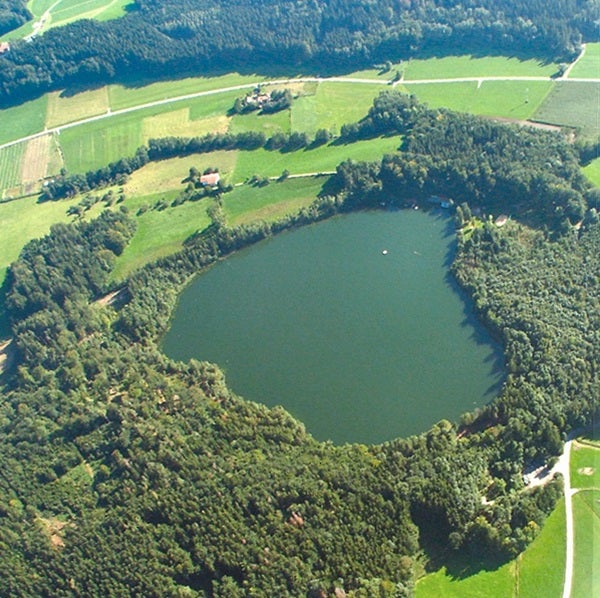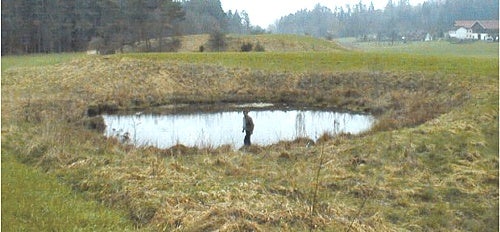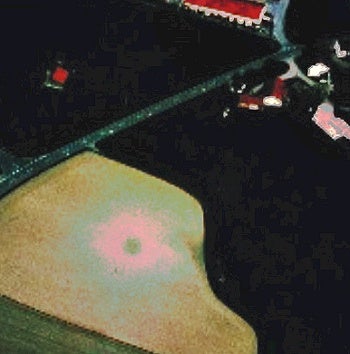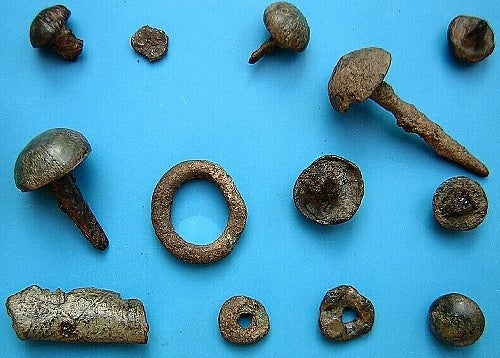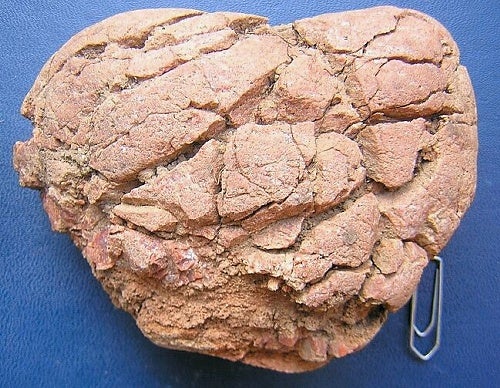We have identified an exceptional field of meteorites and impact craters stretching from the town of Altötting to the area around Lake Chiemsee in southeastern Bavaria, Germany. While there are many meteorite “strewnfields” known around the world, few contain significant craters. The Chiemgau field, which falls within an ellipse 36 miles long and 17 miles (58 by 27 kilometers) wide, holds at least 81 impact craters ranging from 10 to 1,215 feet (3 to 370 meters) in size. Many more craters may lie hidden in heavily forested areas within the ellipse, and farming activities in the region may have destroyed others.
In autumn 2000, a group of amateur archaeologists working the area around Lake Chiemsee discovered pieces of metal containing minerals not found previously in the region. Werner Mayer, the independent scholar who led the amateur team, noticed that the material was associated with what appeared to be impact craters, most of which showed clear rims. In 2004, four other scientists joined Mayer to form the Chiemgau Impact Research Team: Kord Ernstson, a geologist at the University of Würzburg; independent scholar Gerhard Benske; Michael Rappenglück, an astronomer with the Institute for Interdisciplinary Sciences in Gilching; and Ulrich Schüssler, a University of Würzburg mineralogist.
| Meteorite strewnfields with craters | |||
|---|---|---|---|
| name | location | crater no. | width of largest crater |
| Chiemgau | Germany | 81 | 1,215 feet (370m) |
| Henbury | Australia | 13 | 607 feet (158m) |
| Wabar | Saudi Arabia | 4 | 380 feet (116m) |
| Kaalijarvi | Estonia | 9 | 360 feet (110m) |
| Campo del Cielo | Argentina | 9 | 328 feet (100m) |
| Morasko | Poland | 8 | 312 feet (95m) |
| Sikhote Alin | Russia | 159 | 87 feet (26.5m) |
Geological evidence makes clear the site’s extraterrestrial connection. Sandstone boulders and small, weathered rock fragments called cobbles in and around the craters are completely coated by silica glass, which requires unusually high temperatures. We believe the cobbles were superheated and ejected in the impact. We found bluish-gray, dark green, and black glass-like material in unusual shapes — such as teardrops and dumbbells — indicating rapid cooling and solidification during flight.
When did the impact occur? Archaeological finds in the area, as well as the ages of trees within the craters, tell us the impact occurred in historical times. The oldest tree we found rooted in a crater wall is at most 500 years old, and we found xifengite and gupeiite beneath the retaining walls of Burghausen Castle, which has been dated to the 15th century a.d. At another site, we unearthed impact-related minerals along with Celtic artifacts. The artifacts seem to have been strongly heated on one side. This pushes the earliest date for the impact to the late Celtic period, between 480 b.c. and 30 b.c. Radiocarbon dates from ash samples we removed from layers in several craters are not yet available.
The growth patterns of Irish oaks slowed dramatically between a.d. 536 and 545, indicating a much cooler climate. Historical records refer to famine and a dimmed Sun during this period. Many have argued this so-called “dust-veil event” was the aftermath of a large (0.3 mile, or 500m) comet fragment exploding high in Earth’s atmosphere. To date, no craters related to such an event have been found.
However, the rings also show slowed growth around 207 b.c. Roman authors wrote about showers of stones falling from the sky and terrifying the populace. In 205 b.c., because of these events, the Senate ordered that a conical meteorite known as the Needle of Cybele (which had been worshipped in Asia Minor in connection with the fertility goddess Cybele) be brought to Rome. On the rim of the largest crater, named Tüttensee, archaeologists have found Roman relics from about a.d. 200. This, in addition to the heated coins from the late Celtic period we found at the Chiemgau impact site, lead us to favor this early date.
We believe an asteroid or comet fragment exploded above southeastern Germany in the late Celtic period. Our candidate impactor is a low-density object, perhaps something like the C-class asteroid 253 Mathilda. Astronomers believe Mathilda was once completely shattered but reassembled as a loose aggregate of material — that is, a rubble pile. Given the material we recovered and the length of the ellipse of scattered debris, we suggest the impacting body was more likely a comet fragment — rich in methane, ammonia, and water, with a relatively small fraction of rocky matter.
| View details of the impact model and its effects |
What would people on the ground have experienced? About 2 seconds after the strike, people 6 miles (10 km) away would have felt the ground shake as it would in a magnitude 6.0 earthquake. The air blast, arriving 30 seconds after impact, would have swept through at a speed of 500 miles per hour (800 km/h) and produced a peak pressure of about 1.4 atmospheres (142,000 Pa), easily collapsing buildings, especially wooden ones. Even from 10 km away, sound from the impact would have reached 103 decibels — loud enough to cause strong ear pain. Up to 90 percent of the trees would have blown over; the rest would have lost their branches.
We found a thin layer of ash in and between the craters. The forest beneath the blast would have ignited suddenly, burning until the impact’s blast wave shut down the conflagration. Dust may have been blown into the stratosphere, where it would have been transported around the globe easily, so it may be possible to trace the event in ice cores from Greenland or Antarctica.
In any case, the impact undoubtedly had a major effect on the environment and people then living in the vicinity of Altötting-Chiemgau. The region must have been devastated for decades. We are currently looking for gaps in the historical and archaeological records during the time we propose for the impact to better understand both the event itself and its cultural effects.

